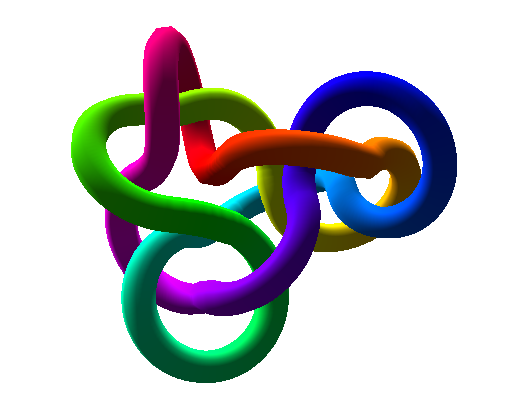Overview¶

pyknotid is a Python module for doing calculations on knots or links, whether specified as space-curves, or via standard topological notations.
Visit Knot ID for an online interface to some of these tools.
Installation¶
You can install pyknotid via pip:
$ pip install pyknotid
By default pyknotid will try to compile some cython modules, but if this fails (normally because cython is not installed) it will only print a message and continue without errors. This won’t impact your use of pyknotid except that the cython calculations would be, especially during space-curve analysis. If you want to use the improved speed of the cython implementations but did not initially install them, you should uninstall pyknotid, install cython, and reinstall pyknotid.
You can also install the pyknotid development version from github at https://github.com/SPOCKnots/pyknotid.
Space curve analysis¶
pyknotid can perform many calculations on space curves specified as a set of points, as well as plotting the curves in three dimensions or in projection. See the space curve documentation for more information.
Some topological calculations can only be performed for relatively short, simple curves, but in general pyknotid can work fine even for space-curves with many thousands of points.
Example:
from pyknotid.make import trefoil
from pyknotid.spacecurves import Knot
k = Knot(trefoil())
k.determinant() # 3
k.gauss_code() # 1+a,2-a,3+a,1-a,2+a,3-a
k.identify() # [<Knot 3_1>]
Topological representations¶
pyknotid can accept input using several standard topological notations including the Gauss code, planar diagram or Dowker-Thistlethwaite notation. You can then calculate topological invariants, or even reconstruct a 3D space curve. See the representation documentation for more information.
Example:
from pyknotid.representations import GaussCode, Representation
gc = GaussCode('1+a,2-a,3+a,1-a,2+a,3-a')
gc.simplify() # does nothing here, as no Reidemeister moves can be
# performed to immediately simplify the curve
# Representation is a generic topological representation providing
# more methods
rep = Representation(gc)
rep.determinant() # 3
rep.space_curve() # <Knot with 34 points>, a space curve with the
# given Gauss code on projection
Knot catalogue¶
pyknotid can look up knot types in a prebuilt database containing
various invariants for knots with up to 15 crossings. They can be
looked up by the knot name (e.g. 3_1 for the trefoil knot, 4_1
for the figure-eight knot etc.), or the values of different knot
invariants. See the knot catalogue documentation for more information.
Example:
from pyknotid.catalogue import get_knot, from_invariants
k = get_knot('5_2')
k.vassiliev_2 # 2
k.determinant() # 3
k = get_knot('7_3').space_curve() # <Knot with 83 points>, a space curve
# that forms a 7_3 knot.
knots = from_invariants(determinant=7, max_crossings=11) # [<Knot 5_2>,
# <Knot 7_1>,
# <Knot 9_42>,
# <Knot K11n57>,
# <Knot K11n96>,
# <Knot K11n111>]
Example knots¶
pyknotid includes several functions for creating example knotted space curves. See the example knots documentation for more details.
Example:
from pyknotid.make import torus_knot
k = torus_knot(p=5, q=2)
k.identify() # [<Knot 5_1>]
from pyknotid.make import torus_link
l = torus_link(p=2, q=8) # a 2-component link
l.linking_number() # 8
from pyknotid.make import figure_eight
k = figure_eight()
k.determinant() # 5